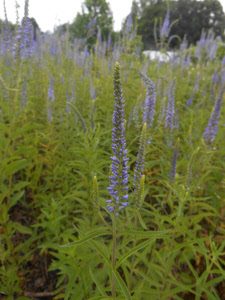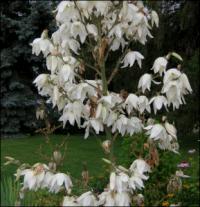Black Walnut Tolerant
Showing 105–106 of 106 results
-
Veronica spicata Speedwell Z 4-8
Erect crowd of bluish-purple star-shaped flowers cover terminal spikes all summer growing high above basil foliage. If deadheaded blooms all summer.
Erect crowd of bluish-purple star-shaped flowers cover terminal spikes all summer growing high above basil foliage. If deadheaded blooms all summer.
Size: 24" x 18-24"
Care: Sun in well-drained soil
Native: Hilly pastures in Europe and North Asia
Wildlife Value: attracts butterfliesAccording to Christian tradition, as Jesus carried the cross to Calvary a woman wiped his face with her handkerchief, leaving the imprint of Christ’s features, the vera iconica, meaning “the true likeness.” When the Catholic Church canonized the woman, the Church gave her the name Saint Veronica. Medieval gardeners named this plant after her due to a perceived likeness of the flower to her handkerchief. Veronicas have been in cultivation since at least Medieval times. Europeans made tea from V. spicata. This was planted in a symmetrical garden at Versailles.
-
Yucca filamentosa syn. Yucca americana Adam’s Needle, Silk grass Z 4-10
July – August flowers with translucent white bells, five feet high, out of a clump of spiky evergreen foliage.
July – August flowers with translucent white bells, five feet high, out of a clump of spiky evergreen foliage.
Size: 30" leaves - 5' flower x 3'
Care: full sun, moist well-drained soil. Drought tolerant
Native: New Jersey to Florida
Wildlife Value: symbiotic relationship with Yucca moth – its only pollinator is the Yucca moth and the Yucca is the only food source for the Yucca moth.
Awards: England's Royal Horticultural Society Award of Garden Merit; Cary Award Distinctive Plants for New England and Elisabeth Carey Miller Botanical Garden Great Plant Pick.IIn 1596 Gerard (1545-1612) named the genus Yucca from the incorrectly identified plant. He named it Iucca. Filimentosa from the Latin “filum” meaning “thread” because of the threads on the leaf margins. Colonists cut the leaves of Y. filamentosa to make thread. Indians used the root as an ingredient in bread, to make suds for cleaning and the leaf fibers to make clothes. For the Cherokee it cured diabetes and skin sores, induced sleep in people and drugged fish for an easier catch. One of earlier No. American plants sent to Europe – grew in Tradescant the Younger’s South Lambeth nursery in 1656. Both Gerard and Parkinson grew Yucca filamentosa in their personal gardens. Jefferson planted this in 1794 and called it “beargrass.” Grown at Elgin Botanic Garden, America’s 1st botanic garden, 1811.


